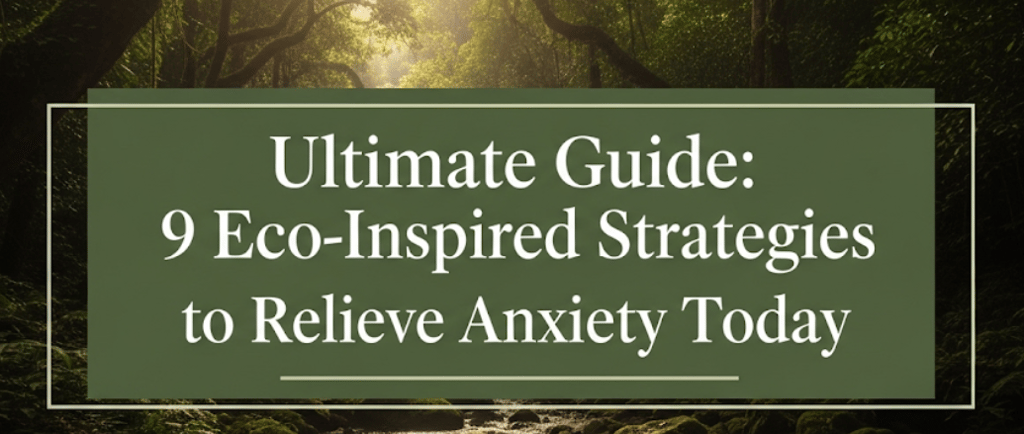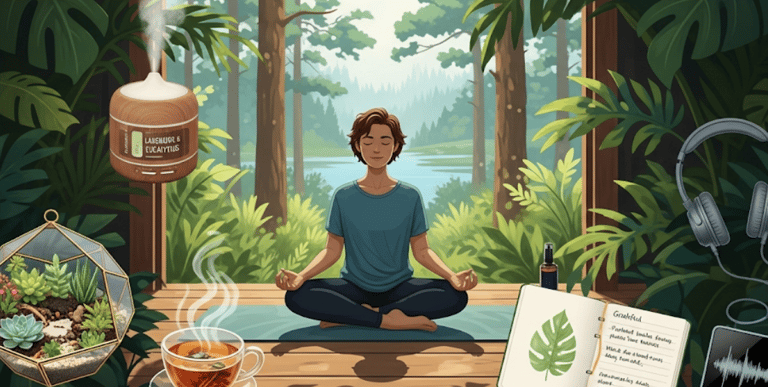Ultimate Guide: 9 Eco-Inspired Strategies to Relieve Anxiety Today
Discover 9 proven eco-inspired strategies to naturally relieve anxiety using nature's healing power. From forest bathing to therapeutic gardening, find your path to calm today with science-backed techniques that work anywhere, anytime for lasting stress relief.
VerdantEase
8/14/202512 min read


Are you tired of constantly battling anxiety and stress? You're not the only one. Rain or shine, millions of people across the world constantly fight off waves of anxious thoughts and feelings. What if the ultimate way to calm your thoughts and ease your nerves is right around the corner, or even outside your window?
Since the beginning of their existence, nature has been the best healer for humans. All the rustling leaves, calming sound of water, these are absolute benefits for anxiety relief! There's no need to rely on prescription bottles or therapy. The following eco-inspired strategies unearth our inner connection with the earth and help achieve peace in a restless society.
We bring you a complete guide including nine nature-based techniques that already proved their efficacy! No matter if you inhabit a city, suburb or countryside, these strategies are effective at any time and in any place. Let's explore how Mother Nature will become your best ally in fighting anxiety!
Why Nature is Ideal for Anxiety Relief
Before diving deep into the strategies, let's take a look at why nature is the ultimate solution for anxiety prevention. As proven by numerous studies, contact with the environment:
• Reduces cortisol – the main stress hormone in your body • Lowers blood pressure and heart rate • Increases levels of mood-regulating serotonin • Enhances focus and clarity • Boosts the immune system
The Japanese meditative technique is called shinrin-yoku or forest bathing. In forest therapy, one should immerse oneself fully and mindfully in contact with nature. A 20-minute forest bath can reduce cortisol levels and improve health for a good half a day!
Strategy 1: Instant Calm with Forest Bathing
How to Practice Forest Bathing:
Get Outside: You're probably thinking how clichéd this is but it's true. Get your butt outside to find your green space; it could be a forest, park or even a tree-lined street.
Detach from Technology: Silence your cell phone and be present fully with nature.
Awaken the Senses: Smell the pine, touch the bark, hear bird calls.
Take Your Time: Walk slowly or sit quietly for about 15–30 minutes.
Breathe More: Take long slow breaths with trees around.
Scientific Benefits:
• Decreases stress-producing hormones by about 50% • Raises immunity guard natural killer cells • Enhances mood in as little as 15 minutes
TIP: In case you can't go to a forest nearby, consider visiting a botanical garden or have some potted plants at home in one of your rooms.
Strategy 2: Water Therapy with Blue Spaces
Water sounds good to hear and even water sights are soothing to the human mind. Known as 'blue space therapy,' it has been shown to lower anxiety levels considerably.
Types of Water Therapy:
Natural Water Sources: • Ocean waves and beach visits • Rivers and streams • Lakes and ponds • Waterfalls and cascades
Urban Water Options: • Fountains in parks or plazas • Swimming pools • Hot springs or spas • Even recorded water sounds
Creating Your Water Sanctuary:
Location
Setup Suggestions
Time Required
Home
Small tabletop fountain, fish tank or any water feature
5-10 minutes
Office
Desk water fountain or nature sounds playlist
2-5 minutes
Outdoor
Visit to nearest lake, river or beach
20-60 minutes
The Science Behind Water Therapy:
Negative ions, which are emitted by water sounds, have been shown to increase serotonin levels, thereby improving mood and lessening anxiety. Additionally, the rhythmic nature of water also helps in regulating breathing patterns and can naturally soothe your nervous system.
Strategy 3: Wild Plant Aromatherapy
These are the many natural compounds in plants that directly affect your mood and stress levels. Wild aromatherapy uses scents from nature as a quick fix to ease anxiety.
Top Natural Scents for Anxiety Management:
Lavender: Most studied scent for anxiety relief
Pine & Cedar: Earthy forest scents that lower cortisol levels
Rose and Jasmine: Effective mood-enhancing fragrances from the floral range
Mint and Eucalyptus: Both scents are invigorating to the brain, making it easier to concentrate
Ocean Breeze: Salty air that promotes deep relaxation
DIY Natural Aromatherapy Methods:
Immediate Relief Techniques: • Break fresh herbs with your fingers — smell them • Collect pine needles or cedar branches for natural scent • Carry dried flowers with you • Tuck herbal sachets in your pocket or under your pillow
Long-term Solutions: • Plant a garden of lavender, rosemary and mint to create your own aromatherapy retreat • Gather and air-dry flowers and herbs in season • Create your own natural room sprays with essential oils and water • Use reed diffusers with essential oils derived from plants
Safety Note: Just make sure you research a plant before using it for aromatherapy purposes. Allergic reactions can occur with some plants and pregnant women should check with their healthcare providers before using essential oils.
Strategy 4: Grounding Activities to Connect with Earth
Grounding (or earthing) is simply direct skin contact with the surface of the Earth. This has been known to help a lot in reducing inflammation, improving sleep and significantly lowering anxiety levels.
Simple Grounding Exercises:
Basic Grounding (5-10 minutes): • Remove shoes and socks • Stand or walk on grass, sand or bare soil • Feel the Earth under your feet • Take a deep breath and picture roots sprouting from your feet into the soil
Advanced Grounding (15-30 minutes): • Lie down on natural ground • Put your hands on the earth • Imagine negative energy being released from your body into the ground • Take in positive earth energy
Indoor Grounding Alternatives:
These options are worth trying when outdoor grounding is not possible: • Use grounding mats or sheets • Hold stones or crystals from nature • Practice visualization while touching houseplants • Sit by an open window
The Electrical Connection:
Mother Earth carries a negative electrical charge while chronic stress pushes free radicals into our bodies creating positive electrical charges. Touch with the earth helps to neutralize positive charge, thus decreasing inflammation and soothing tension.
Strategy 5: Therapeutic Gardening for Mental Wellness
With gardening, you are able to move your body, engage in mindfulness and connect with living beings. This trio of beneficial effects makes it one of the best anxiety eco-therapies.
Mental Health Benefits of Gardening:
Immediate Stress Relief: The repetitive, meditative movements of digging, planting and watering
Sense of Purpose: Having something living for which you are responsible
Achievement: Watching plants thrive brings feelings of accomplishment and growth
Physical Movement: Activity releases endorphins
Vitamin D Production: Outdoor gardening increases sun exposure
Anxiety-Reducing Garden Ideas:
Small Space Gardens: • Herb containers on windowsills • Succulent arrangements • Vertical wall gardens • Balcony vegetable boxes
Therapeutic Plant Choices: • Lavender: Promotes relaxation, smells lovely, beautiful purple flowers • Chamomile: Makes relaxing tea and attracts beneficial insects • Basil: Edible and a natural stress reducer • Sunflowers: Bright, cheerful, and fast-growing • Mint: Invigorating scent and multipurpose
Getting Started with Therapeutic Gardening:
Week 1: Pick out 2–3 simple plants and basic supplies Week 2: Create a ten-minute daily gardening habit Week 3: Introduce mindfulness practices during gardening Week 4: Expand your garden or try new types of plants
Essential Supplies for Beginners:
• Quality potting soil • Appropriate containers with drainage • Hand tools (trowel, pruners, watering can) • Seeds or starter plants • Natural fertilizer
Strategy 6: Seasonal Rituals for Year-Round Harmony
Every season offers unique ways to connect with nature for anxiety relief. Seasonal rituals help you stay grounded throughout the year.
Spring Renewal Rituals (March-May):
• Fresh Start Walks: Walk daily observing new growth • Seed Planting Ceremony: Plant seeds with intention and positive mantras • Spring Cleaning: Clear garden beds or nature spaces • Flower Observation: Stop and appreciate blooming flowers
Summer Energy Rituals (June-August):
• Sunrise/Sunset Viewing: Begin or end days with natural light • Outdoor Meditation: Practice mindfulness in good weather • Water Activities: Swimming or sitting near water bodies • Harvest Gratitude: Pick berries, herbs or vegetables mindfully
Autumn Reflection Rituals (September-November):
• Leaf Collection: Gather colorful leaves for art or decoration • Nature Journaling: Document seasonal changes and personal growth • Seed Collection: Mindfully gather nature's offerings • Gratitude Walks: Reflect on the year's blessings
Winter Restoration Rituals (December-February):
• Pine Aromatherapy: Bring pine or fir branches indoors • Bird Feeding: Connect with wildlife during cold months • Snow Meditation: Practice mindfulness in winter weather • Houseplant Care: Tend to living reminders of spring
Creating Your Personal Seasonal Calendar:
Season
Activities
Duration
Spring
Garden planning, seed starting
15-30 min, 3x per week
Summer
Outdoor meditation, water play
15-45 minutes daily
Fall
Nature collecting, gratitude practice
10-20 min, 4x per week
Winter
Indoor plant care, bird watching
5-15 minutes daily


Strategy 7: Mindful Wildlife Watching
Wildlife observation is a profoundly calming experience that helps ease anxiety as wonder for these animals unfolds before our eyes, helping us lose ourselves in the here and now.
Benefits of Wildlife Observation:
Present Living: Animals force you to be present
Mental Meditation: Bird watching quiets mental chatter
Perspective Shift: Observing natural behavior reduces personal worries
Joy and Wonder: Wildlife encounters enhance positive emotions
Patience Building: Learning to wait quietly builds tolerance
Easy Wildlife Watching Opportunities:
Urban Wildlife Options: • Birds at feeders or in parks • Squirrels and urban mammals • Insects like butterflies and bees • Fish in ponds or aquariums • Domestic animals like cats and dogs
Suburban and Rural Options: • Backyard bird watching • Garden visitors like rabbits and deer • Pond or stream creatures • Forest animals during quiet walks • Farm animals if accessible
Creating Wildlife-Friendly Spaces:
Simple Additions for Any Space: • Bird Feeders: Different seed types attract various species • Water Sources: Shallow dishes or bird baths • Native Plants: Provide food and habitat for local wildlife • Brush Piles: Natural cover for small animals • Chemical-Free Environment: Keep area safe for creatures
Mindful Wildlife Observation Technique:
Choose a Comfortable Spot: Find a place where animals are seen
Breathe Deeply: Use slower breaths to ground your energy
Observe Without Judging: Watch behaviors without seeking understanding
Notice Details: Colors, movements, sounds and interactions
Be Patient: Let animals come to you rather than chasing them
Express Gratitude: Appreciate witnessing wild behavior
Strategy 8: Natural Audio Healing and Soundscapes
Sound plays a crucial role in managing anxiety. Natural sounds regulate your nervous system and induce profound relaxation responses.
Best Natural Sounds for Anxiety:
High-Impact Calming Sounds: • Ocean waves: Rhythmic, consistent – best for sleeping • Rain: Drowns out noise and creates mild weather comfort • Forest Sounds: Bird calls, wind rustling through leaves, insect chirping • Water Flow: Rivers, streams and waterfalls focus attention • Wind Through Trees: Quiet whooshing, slows breathing
Creating Your Natural Sound Environment:
Outdoor Sound Experiences: • Sit in parks during different weather conditions • Find quiet spots with natural soundscapes • Practice sound meditation – just listen • Record your preferred natural sounds for later playback
Indoor Sound Solutions: • Nature sound apps or recordings • Small indoor water features for consistent sound • Wind chimes near open windows • Bird-attracting plants by windows
Sound Healing Practice Schedule:
Time of Day
Best Sounds
Duration
Purpose
Morning
Birdsong, flowing water
10-15 min
Energy & focus
Midday
Forest sounds, wind
5-10 min
Stress reset
Evening
Ocean waves, light rain
15-30 min
Relaxation
Bedtime
Subtle rainfall, distant thunder
30-60 min
Sleep preparation
DIY Natural Sound Recording:
Create personal sound libraries by: • Recording favorite outdoor locations • Collecting sounds from different seasons • Sharing recordings with friends and family • Using recordings for immediate stress relief
Strategy 9: Align with Moon Cycles and Natural Rhythms
Working with natural cycles is another way to create sustainable anxiety management. Different healing activities are organized around moon phases.
Understanding Lunar Influences on Mood:
While the science is limited, many people find themselves feeling heightened emotions during full moons and more introspective energy around new moons. Whether the moon actively influences us or not, using lunar-based practices can scaffold your anxiety relief efforts.
Moon Phase Anxiety Relief Activities:
New Moon (New Beginnings — Days 1–3): • Set intentions for anxiety management • Start new nature-based habits • Plant seeds (literally and metaphorically) • Practice quiet reflection and planning
Waxing Moon (Growth Energy — Days 4–13): • Increase outdoor activity levels • Build momentum with established practices • Try new nature experiences • Focus on growth and expansion
Full Moon (High Energy — Days 14–16): • Engage in vigorous outdoor activities • Release anxious thoughts through journaling • Celebrate progress and achievements • Participate in community outdoor activities
Waning Moon (Releasing Energy — Days 17–28): • Focus on releasing negative thoughts • Practice gentle, restorative nature activities • Evaluate what's working and what isn't • Prepare for the next cycle
Monthly Nature-Based Anxiety Relief Cycle:
Week 1 (New Moon): Planning and intention setting • Explore new nature locations • Set realistic goals for outdoor time • Start new plant or garden projects
Week 2 (Waxing Moon): Building and growing • Increase time spent in nature • Try new outdoor activities • Keep a nature journal
Week 3 (Full Moon): Maximum activity and release • Engage in vigorous outdoor activities • Release tensions in nature • Celebrate successes and progress
Week 4 (Waning Moon): Rest and reflection • Gentle nature activities like peaceful walks • Evaluate what's working and what isn't • Prepare for next month's cycle
Creating Your Personal Eco-Anxiety Relief Plan
Armed with knowledge of all nine strategies, it's time to create a plan that suits your lifestyle, location, and anxiety triggers.
Step 1: Assess Your Current Situation
Answer these questions: • When do you experience the most anxiety throughout the day? • How much time can you realistically dedicate to nature-related activities? • What natural spaces are accessible to you? • Which of the nine strategies seems most appealing to start with? • What barriers prevent you from spending time in nature?
Step 2: Choose Your Starting Strategy
For Beginners: Aromatherapy, wildlife observation Busy Schedules: Grounding techniques, natural sounds Physical Activity Lovers: Forest bathing, therapeutic gardening Indoor Preferences: Houseplants, natural sound healing
Step 3: Create Your Weekly Routine
Sample Weekly Eco-Anxiety Relief Schedule:
Day
Morning (10 min)
Midday (5 min)
Evening (15 min)
Monday
Forest bathing walk
Desk plant care
Natural sounds
Tuesday
Aromatherapy ritual
Grounding break
Garden time
Wednesday
Wildlife watching
Nature sounds
Moon observation
Thursday
Water therapy
Breathing by plants
Seasonal ritual
Friday
Garden meditation
Herbal aromatherapy
Sound healing
Weekend
Extended nature time
Flexible activities
Planning next week
Step 4: Track Your Progress
Keep a simple anxiety relief journal: • Rate anxiety levels before and after each activity (1–10 scale) • Note which techniques are more effective • Track patterns by weather and season • Record any insights or breakthroughs
Step 5: Adapt and Evolve
Monthly Review Questions: • Which techniques were most effective for anxiety relief? • What got in your way, and how can you overcome it? • Has your relationship with nature shifted? • What new strategies would you like to try next month?
Overcoming Common Challenges
Even the best anxiety relief plans face obstacles. Here are common problems and solutions:
"I Don't Have Time"
Solutions: • Start with just 5 minutes each day • Combine nature time with other activities (eat outside, walking meetings) • Use transition periods (play nature sounds while commuting) • Practice micro-doses — gazing out windows, touching plants
"I Live in a City"
Solutions: • Find urban green spaces and pocket parks • Create indoor nature oases with plants and nature sounds • Visit rooftop gardens, botanical or community gardens • Plan weekend trips to nearby natural areas
"I'm Not an Outdoor Person"
Solutions: • Prioritize indoor nature activities • Start with gentle, low-impact outdoor experiences • Focus on sensory experiences rather than physical challenges • Bring comfort items for outdoor activities
"Weather Limits My Options"
Solutions: • Develop weather-specific strategies for each season • Invest in appropriate clothing for different conditions • Create backup indoor alternatives • Embrace weather as part of the natural experience
Long-Term Benefits and Lifestyle Integration
Anxiety relief is not a one-time achievement but an ongoing process.
Expected Timeline for Results:
• Immediate: Feel calmer after first several activities • One Month: Noticeable improvements in anxiety management • Three Months: Deeper habits and meaningful nature connection • Six Months: Significant overall improvement in well-being • One Year: Nature becomes integral to anxiety management
Signs of Successful Integration:
• Automatically think of nature when feeling anxious • Notice seasonal changes affecting your mood • Feel comfortable and at home in natural settings • View nature as a reliable source of peace
Building Community Around Nature
These activities are more enjoyable when shared: • Join local nature groups or hiking clubs • Start a community garden • Organize outdoor meditation sessions • Share favorite nature spots with friends • Practice eco-therapy techniques with family
Conclusion: Your Path to Natural Tranquility
Anxiety doesn't have to rule your life. The nine eco-inspired strategies in this guide create a toolkit for cultivating peace through nature's healing power. From simple grounding exercises to profound forest bathing experiences, each practice taps into nature's inherent capacity to soothe, restore, and heal.
Remember that building a relationship with nature is a gradual process. Start small and stay consistent—you might discover unexpected ways natural environments support your mental health. Whether you're dealing with daily stress, chronic anxiety, or seeking more balance in life, these scientifically-backed methods offer a sustainable path forward.
The most beautiful aspect of eco-inspired anxiety relief is that healing yourself also helps heal our world. This deeper connection to nature makes you more conscious of preservation and conservation. Your healing journey integrates with care for personal and planetary wellness.
Take the first step today. Choose one method that speaks to you, step outside, and discover the profound peace nature offers. She waits with open arms to embrace the calmer, more grounded future version of yourself.
Frequently Asked Questions (FAQs)
Q: When should I expect results from these eco-inspired anxiety strategies? A: Most people experience immediate stress relief with techniques like forest bathing or natural sound therapy in the first session. For ongoing anxiety management, expect noticeable changes within 2–4 weeks of regular practice. Consistency matters more than intensity.
Q: Can these natural methods replace my anxiety medication? A: These eco-inspired strategies complement but should never replace professional medical treatment without physician guidance. While nature-based approaches may help reduce medication dependency over time, always work with healthcare professionals.
Q: What if I have fears about bugs or outdoor animals? A: Start gently within your comfort zone. Begin with indoor activities like houseplants, nature sounds and aromatherapy. Gradually ease into outdoor settings when ready. Bring a trusted friend and remember that facing fears step-by-step can ultimately reduce overall anxiety.
Q: Are these strategies effective for severe anxiety disorders? A: While eco-inspired strategies can help with all anxiety levels, severe anxiety disorders typically require professional treatment. Natural methods work best as part of comprehensive treatment including therapy, medication and other interventions. Many therapists incorporate ecotherapy into their practice.
Q: How much time do I need to spend to see benefits? A: Start with 5–10 minutes daily. Studies show that even 15-minute nature exposure can decrease stress hormones and boost mood. For optimal benefits, aim for 20+ minutes several times per week. Consistency trumps duration.
Q: What if I live in an apartment with no outdoor access? A: Urban dwellers can benefit through indoor plants, natural lighting, nature sounds, aromatherapy with essential oils, and regular visits to nearby parks or green spaces. Most cities offer rooftop gardens, urban nature centers, and community gardens for apartment residents.
Q: Are these natural anxiety relief methods safe? A: Most techniques are very safe, but use common sense. Research any plants before using for aromatherapy to avoid allergic reactions. When outdoors, use sun protection, stay hydrated, and be aware of local wildlife. Adapt activities to your physical abilities and health conditions.
Q: Are these eco-anxiety strategies suitable for children? A: Absolutely! Children often respond even better than adults to nature-based anxiety solutions. Gardening, wildlife watching, and outdoor play are excellent for helping young people connect with nature. Always supervise children with plants and outdoor activities, ensure age-appropriate experiences, and research any unfamiliar plants or activities.
Q: What if it's winter or bad weather and I can't maintain these practices? A: Adapt strategies seasonally. Winter might include evergreen aromatherapy, bird feeding, or caring for indoor plants. Rainy days are perfect for nature sounds, tending houseplants, or planning future outdoor activities. Some experiences like listening to thunder or watching snowfall are actually enhanced by stormy weather.
Q: What if I don't see any improvement in my anxiety? A: Give strategies at least 2-3 weeks of consistent practice before evaluating effectiveness. Everyone responds differently, so experiment to find what works for you. Consider keeping a simple journal to track subtle changes that might not be immediately obvious. If anxiety persists, consult a mental health professional to explore whether additional interventions are needed.


